Biodiesel Production from Waste Palm Cooking Oil Using Immobilized Candida rugosa Lipase
Abstract
:1. Introduction
2. Materials and Methods
2.1. WPCO
2.2. Optimization of Biodiesel
2.2.1. Effect of Ethanol to Oil Molar Ratio
2.2.2. Effect of Water Content
2.2.3. Effect of Temperature
2.2.4. Effect of Immobilized Lipase Loading
2.2.5. Effect of Reaction Time
2.3. Biodiesel Analysis by Gas Chromatography Mass Spectrometry
3. Results
3.1. WPCO Properties
3.2. FFA Composition of WPCO
3.3. Effect of Process Parameters on Biodiesel Yield
3.3.1. Effect of Ethanol to Oil Molar Ratio
3.3.2. Effect of Water Content
3.3.3. Effect of Temperature
3.3.4. Effect of Lipase Loading
3.3.5. Effect of Reaction Time
3.4. Ethyl Ester Produced from Transesterification
3.5. Biodiesel Optimization
4. Conclusions
Author Contributions
Funding
Institutional Review Board Statement
Informed Consent Statement
Data Availability Statement
Acknowledgments
Conflicts of Interest
Nomenclature
| WPCO | Waste palm cooking oil |
| WCO | Waste cooking oil |
| FAME | Fatty acid methyl esters |
| FAEE | Fatty acid ethyl esters |
| FFA | Free fatty acids |
| FA | Fatty acid |
| IS | Internal standard |
| GCMS | Gas chromatography mass spectrometry |
| HPLC | High performance liquid chromatography |
References
- Peng, Y.; Amesho, K.T.T.; Chen, C.; Jhang, S.; Chou, F.; Lin, Y. Optimization of Biodiesel Production from Waste Cooking Oil Using Waste Eggshell as a Base Catalyst under a Microwave Heating System. Catalysts 2018, 8, 81. [Google Scholar] [CrossRef] [Green Version]
- Liu, Y.; Yang, X.; Adamu, A.; Zhu, Z. Current Research in Green and Sustainable Chemistry Economic Evaluation and Production Process Simulation of Biodiesel Production from Waste Cooking Oil. Curr. Res. Green Sustain. Chem. 2021, 4, 100091. [Google Scholar] [CrossRef]
- Etim, A.O.; Musonge, P.; Eloka-Eboka, A.C. Effectiveness of biogenic waste-derived heterogeneous catalysts and feedstock hybridization techniques in biodiesel production. Biofuels Bioprod. Biorefining 2020, 14, 620–649. [Google Scholar] [CrossRef]
- Amenaghawon, A.N.; Obahiagbon, K.; Isesele, V.; Usman, F. Optimized Biodiesel Production from Waste Cooking Oil Using a Functionalized Bio-Based Heterogeneous Catalyst. Clean. Eng. Technol. 2022, 8, 100501. [Google Scholar] [CrossRef]
- Gaur, V.K.; Sharma, P.; Sirohi, R.; Awasthi, M.K.; Dussap, C.; Pandey, A. Assessing the Impact of Industrial Waste on Environment and Mitigation Strategies: A Comprehensive Review. J. Hazard. Mater. 2020, 398, 123019. [Google Scholar] [CrossRef] [PubMed]
- Khan, H.M.; Iqbal, T.; Yasin, S.; Irfan, M.; Kazmi, M.; Fayaz, H.; Mujtaba, M.A.; Ali, C.H.; Kalam, M.A.; Soudagar, M.E.M.; et al. Production and Utilization Aspects of Waste Cooking Oil Based Biodiesel in Pakistan. Alex. Eng. J. 2021, 60, 5831–5849. [Google Scholar] [CrossRef]
- Yang, J.; Shan, H. The Willingness of Submitting Waste Cooking Oil (WCO) to Biofuel Companies in China: An Evolutionary Analysis in Catering Networks. J. Clean. Prod. 2021, 282, 125331. [Google Scholar] [CrossRef]
- Yusoff, M.N.A.M.; Zulkifli, N.W.M.; Sukiman, N.L.; Kalam, M.A.; Masjuki, H.H.; Syahir, A.Z.; Awang, M.S.N.; Mujtaba, M.A.; Milano, J.; Shamsuddin, A.H. Microwave Irradiation-Assisted Transesterification of Ternary Oil Mixture of Waste Cooking Oil–Jatropha Curcas—Palm Oil: Optimization and Characterization. Alex. Eng. J. 2022, 61, 9569–9582. [Google Scholar] [CrossRef]
- Ali, C.H.; Qureshi, A.S.; Mbadinga, S.M.; Liu, J.; Yang, S.; Mu, B. Biodiesel Production from Waste Cooking Oil Using Onsite Produced Purified Lipase from Pseudomonas Aeruginosa FW_SH-1: Central Composite Design Approach. Renew. Energy 2017, 109, 93–100. [Google Scholar] [CrossRef]
- Vergel-ortega, M.; Valencia-ochoa, G.; Duarte-forero, J. Experimental Study of Emissions in Single-Cylinder Diesel Engine Operating with Diesel-Biodiesel Blends of Palm Oil-Sunflower Oil and Ethanol. Case Stud. Therm. Eng. 2021, 26, 101190. [Google Scholar] [CrossRef]
- Zahan, K.; Kano, M. Biodiesel production from palm oil, its by-products, and mill effluent: A review. Energies 2018, 11, 2132. [Google Scholar] [CrossRef] [Green Version]
- Samanta, S.; Sahoo, R.R. Waste Cooking (Palm) Oil as an Economical Source of Biodiesel Production for Alternative Green Fuel and Efficient Lubricant. BioEnergy Res. 2021, 14, 163–174. [Google Scholar] [CrossRef]
- Suzihaque, M.U.H.; Alwi, H.; Kalthum, U.; Abdullah, S.; Haron, N. Materials Today: Proceedings Biodiesel Production from Waste Cooking Oil: A Brief Review. Mater. Today Proc. 2022, 63, S484–S489. [Google Scholar] [CrossRef]
- Villeneuve, P.; Muderhwa, J.M.; Graille, J.; Haas, M.J. Customizing lipases for biocatalysis: A survey of chemical, physical and molecular biological approaches. J. Mol. Catal. B Enzym. 2000, 9, 113–148. [Google Scholar] [CrossRef]
- Binhayeeding, N.; Klomklao, S.; Prasertsan, P.; Sangkharak, K. Improvement of Biodiesel Production Using Waste Cooking Oil and Applying Single and Mixed Immobilised Lipases on Polyhydroxyalkanoate. Renew. Energy 2020, 162, 1819–1827. [Google Scholar] [CrossRef]
- Jung, S.; Shetti, N.P.; Reddy, K.R.; Nadagouda, M.N.; Park, Y.; Aminabhavi, T.M.; Kwon, E.E. Synthesis of Different Biofuels from Livestock Waste Materials and Their Potential as Sustainable Feedstocks—A Review. Energy Convers. Manag. 2021, 236, 114038. [Google Scholar] [CrossRef]
- Abdulla, R.; Ravindra, P. Immobilized Burkholderia Cepacia Lipase for Biodiesel Production from Crude Jatropha Curcas L. Oil. Biomass Bioenergy 2013, 56, 8–13. [Google Scholar] [CrossRef]
- Muhammad, G.; Alam, M.A.; Mofijur, M.; Jahirul, M.I.; Lv, Y.; Xiong, W.; Xu, J. Modern developmental aspects in the field of economical harvesting and biodiesel production from microalgae biomass. Renew. Sustain. Energy Rev. 2022, 135, 110209. [Google Scholar] [CrossRef]
- Dwiarti, L.; Ali, E.; Park, E.Y. Enhancement of lipase catalyzed-fatty acid methyl esters production from waste activated bleaching earth by nullification of lipase inhibitors. Bioresour. Technol. 2010, 101, 14–20. [Google Scholar] [CrossRef] [Green Version]
- Marín-Suárez, M.; Mendez-Mateos, D.; Guadix, A.; Guadix, E.M. Reuse of Immobilized Lipases in the Transesterification of Waste Fish Oil for the Production of Biodiesel. Renew. Energy 2019, 140, 1–8. [Google Scholar] [CrossRef]
- Abdulla, R.; Pogaku, R. Advances in Biofuels; Pogaku, R., Sarbatly, R.H., Eds.; Springer Science and Business Media: New York, NY, USA, 2013; pp. 191–216. ISBN 9781461462484. [Google Scholar]
- Pasha, M.K.; Dai, L.; Liu, D.; Guo, M.; Du, W. Biotechnology for Biofuels An Overview to Process Design, Simulation and Sustainability Evaluation of Biodiesel Production. Biotechnol. Biofuels 2021, 14, 129. [Google Scholar] [CrossRef]
- Kadapure, S.A.; Kirti, P.; Singh, S.; Kokatnur, S.; Hiremath, N.; Variar, A.; Shaikh, S.; Chittaragi, R. Studies on Process Optimization of Biodiesel Production from Waste Cooking and Palm Oil. Int. J. Sustain. Eng. 2018, 11, 167–172. [Google Scholar] [CrossRef]
- Thoai, D.N.; Le Hang, P.T.; Lan, D.T. Pre-Treatment of Waste Cooking Oil with High Free Fatty Acids Content for Biodiesel Production: An Optimization Study via Response Surface Methodology. Vietnam J. Chem. 2019, 57, 568–573. [Google Scholar] [CrossRef]
- Akoh, C.C.; Shaw, J.F.; Chang, S.W.; Lin, S.C.; Wu, T.T.; Ju, H.Y.; Shieh, C.J. Continuous enzymatic synthesis of biodiesel with Novozym 435. Energy Fuels 2008, 22, 840–844. [Google Scholar]
- Fukuda, H.; Kondo, A.; Noda, H. Biodiesel fuel production by transesterification of oils. J. Biosci. Bioeng. 2001, 92, 405–416. [Google Scholar] [CrossRef]
- Shah, S.; Sharma, S.; Gupta, M.N. Biodiesel preparation by lipase-catalyzed transesterification of Jatropha oil. Energy Fuels 2004, 18, 154–159. [Google Scholar] [CrossRef]
- Phan, A.N.; Phan, T.M. Biodiesel production from waste cooking oils. Fuel 2008, 87, 3490–3496. [Google Scholar] [CrossRef]
- Felizardo, P.; Neiva Correia, M.J.; Raposo, I.; Mendes, J.F.; Berkemeier, R.; Bordado, J.M. Production of biodiesel from waste frying oils. Waste Manag. 2006, 26, 487–494. [Google Scholar] [CrossRef] [PubMed]
- Leung, D.Y.C.; Guo, Y. Transesterification of neat and used frying oil: Optimization for biodiesel production. Fuel Process. Technol. 2006, 87, 883–890. [Google Scholar] [CrossRef]
- Chen, Y.; Xiao, B.; Chang, J.; Fu, Y.; Lv, P.; Wang, X. Synthesis of biodiesel from waste cooking oil using immobilized lipase in fixed bed reactor. Energy Convers. Manag. 2009, 50, 668–673. [Google Scholar] [CrossRef]
- Pazouki, M.; Zamani, F.; Zamzamian, A.H.; Fahar, M.; Najafpour, G.H. Esterification of free fatty acids by Rhizopus oryzae as cell-catalyzed from used cooking oil for biodiesel production. World Appl. Sci. 2010, 8, 719–724. [Google Scholar]
- Ghazali, M.; Hidayah, N.; Gimbun, J.; Nurdin, S. Transesterification of Waste Cooking Oil using Chemically Treated Catalyst. J. Appl. Sci. 2014, 14, 1425–1429. [Google Scholar]
- Al-Zuhair, S.; Dowaidar, A.; Kamal, H. Dynamic modeling of biodiesel production from simulated waste cooking oil using immobilized lipase. Biochem. Eng. J. 2009, 44, 256–262. [Google Scholar] [CrossRef]
- Degfie, T.A.; Mamo, T.T.; Mekonnen, Y.S. Optimized Biodiesel Production from Waste Cooking Oil (WCO) Using Calcium Oxide (CaO) Nano-Catalyst. Sci. Rep. 2019, 9, 18982. [Google Scholar] [CrossRef] [Green Version]
- Yahya, S.; Razali, F.H.; Harun, F.W. Physicochemical Properties of Refined Palm Cooking Oil and Used Palm Cooking Oil. Mater. Today Proc. 2019, 19, 1166–1172. [Google Scholar] [CrossRef]
- Anantapinitwatna, A.; Ngaosuwan, K.; Kiatkittipong, W. Effect of Water Content in Waste Cooking Oil on Biodiesel Production via Ester-Transesterification in a Single Reactive Distillation. IOP Conf. Ser. Mater. Sci. Eng. 2019, 559, 012014. [Google Scholar] [CrossRef]
- Linganiso, E.C.; Tlhaole, B.; Magagula, L.P.; Dziike, S.; Linganiso, L.Z.; Motaung, T.E.; Moloto, N.; Tetana, Z.N. Biodiesel Production from Waste Oils: A South African Outlook. Sustainability 2022, 14, 1983. [Google Scholar] [CrossRef]
- Simasatitkul, L.; Gani, R.; Arpornwichanop, A. Optimal Design of Biodiesel Production Process from Waste Cooking Palm Oil. Procedia Eng. 2012, 42, 1411–1420. [Google Scholar] [CrossRef] [Green Version]
- Awogbemi, O.; Onuh, E.I.; Inambao, F.L. Comparative Study of Properties and Fatty Acid Composition of Some Neat Vegetable Oils and Waste Cooking Oils. Int. J. Low-Carbon Technol. 2019, 14, 417–425. [Google Scholar] [CrossRef]
- Krishna, B.S.V.S.R.; Shivaraj, B.K. Estimation of Properties of Mixed Waste Cooking Oil for Production of Biodiesel. Int. J. Eng. Technol. 2018, 7, 552–555. [Google Scholar] [CrossRef] [Green Version]
- Ahmad, N.A.; Zainal, Z.A. Performance and Chemical Composition of Waste Palm Cooking Oil as Scrubbing Medium for Tar Removal from Biomass Producer Gas. J. Nat. Gas Sci. Eng. 2016, 32, 256–261. [Google Scholar] [CrossRef]
- Nayak, S.K.; Mishra, P.C.; Behera, G.R. Experimental Investigation on Dual-Fuel Engine Utilizing Waste Cooking Oil and Producer Gas. Energy Sources Part A Recovery Util. Environ. Eff. 2017, 39, 369–376. [Google Scholar] [CrossRef]
- Alias, N.I.; Jayakumar, J.K.; Md Zain, S. Characterization of Waste Cooking Oil for Biodiesel Production. J. Kejuruter. SI 2018, 1, 79–83. [Google Scholar]
- Mansir, N.; Teo, S.H.; Rashid, U.; Saiman, M.I.; Tan, Y.P.; Alsultan, G.A.; Taufiq-Yap, Y.H. Modified waste egg shell derived bifunctional catalyst for biodiesel production from high FFA waste cooking oil. A review. Renew. Sustain. Energy Rev. 2018, 82, 3645–3655. [Google Scholar] [CrossRef]
- Tan, T.; Lu, J.; Nie, K.; Deng, L.; Wang, F. Biodiesel production with immobilized lipase: A review. Biotechnol. Adv. 2010, 28, 628–634. [Google Scholar] [CrossRef]
- Hanif, M.A.; Nisar, S.; Akhtar, M.N.; Nisar, N.; Rashid, N. Optimized Production and Advanced Assessment of Biodiesel: A Review. Int. J. Energy Resour. 2018, 42, 2070–2083. [Google Scholar] [CrossRef]
- Hundie, K.B.; Akuma, D.A. Heliyon Optimization of Biodiesel Production Parameters from Prosopis Julifera Seed Using definitive Screening Design. Heliyon 2022, 8, e08965. [Google Scholar] [CrossRef]
- Tomasevic, A.V.; Siler-Marinkovic, S.S. Methanolysis of used frying oil. Fuel Process. Technol. 2003, 81, 1–6. [Google Scholar] [CrossRef]
- Lu, J.; Chen, Y.; Wang, F.; Tan, T. Effect of water on methanolysis of glycerol trioleate catalyzed by immobilized lipase Candida sp. in organic solvent system. J. Mol. Catal. B Enzym. 2009, 56, 122–125. [Google Scholar] [CrossRef]
- Tan, T.; Nie, K.; Wang, F. Production of biodiesel by immobilized Candida sp. lipase at high water content. Appl. Biochem. Biotechnol. 2006, 128, 109–116. [Google Scholar] [CrossRef]
- Jegannathan, K.R.; Abang, S.; Poncelet, D.; Chan, E.S.; Ravindra, P. Production of biodiesel using immobilized lipase—A critical review. Crit. Rev. Biotechnol. 2008, 28, 253–264. [Google Scholar] [CrossRef] [PubMed]
- Chen, G.; Ying, M.; Li, W. Enzymatic conversion of waste cooking oils into alternative fuel—Biodiesel. Appl. Biochem. Biotechnol. 2006, 132, 911–921. [Google Scholar] [CrossRef]
- Dhawane, S.H.; Bora, A.P.; Kumar, T.; Halder, G. Parametric optimization of biodiesel synthesis from rubber seed oil using iron doped carbon catalyst by Taguchi approach. Renew. Energy 2017, 105, 616–624. [Google Scholar] [CrossRef]
- Bautista, L.F.; Vicente, G.; Rodriguez, R.; Pacheco, M. Optimisation of FAME production from waste cooking oil for biodiesel use. Biomass Bioenergy 2009, 33, 862–872. [Google Scholar] [CrossRef]
- Zulqarnain; Ayoub, M.; Yusoff, M.H.M.; Nazir, M.H.; Zahid, I.; Ameen, M.; Sher, F.; Floresyona, D.; Budi Nursanto, E. A Comprehensive Review on Oil Extraction and Biodiesel Production Technologies. Sustainability 2021, 13, 788. [Google Scholar] [CrossRef]
- Karmee, S.K. Liquid Biofuels from Food Waste: Current Trends, Prospect and Limitation. Renew. Sustain. Energy Rev. 2016, 53, 945–953. [Google Scholar] [CrossRef]
- Akhtar, M.T.; Ahmad, M.; Asma, M.; Munir, M.; Zafar, M.; Sultana, S.; Mujtaba, M.A.; Mohamed, A.; Kalam, M.A. Efficient Production of Wild and Non-Edible Brassica juncea (L.) Czern. Seed Oil into High-Quality Biodiesel via Novel, Green and Recyclable NiSO 4 Nano-Catalyst. Sustainability 2022, 14, 10188. [Google Scholar] [CrossRef]
- Bharathiraja, B.; Raj, A.S.; Jayamuthunagai, J.; Jayakumar, M.; Kirubakaran, M.A.; Vivek, P.; Palani, S. Optimization of biodiesel production from waste cooking oil using pure lipase and rhizopus oryzae through response surface methodology. Asian J. Microbiol. Biotechnol. Environ. Sci. 2013, 16, 63–70. [Google Scholar]
- Al-Widyan, M.I.; Al-Shyoukh, A.O. Experimental evaluation of the transesterification of waste palm oil into biodiesel. Bioresour. Technol. 2002, 85, 253–256. [Google Scholar] [CrossRef]
- Almeida, V.F.; García-Moreno, P.J.; Guadix, A.; Guadix, E.M. Biodiesel production from mixtures of waste fish oil, palm oil and waste frying oil: Optimization of fuel properties. Fuel Process. Technol. 2015, 133, 152–160. [Google Scholar] [CrossRef]
- Danane, F.; Bessah, R.; Alloune, R.; Tebouche, L.; Madjene, F.; Kheirani, A.Y.; Bouabibsa, R. Experimental Optimization of Waste Cooking Oil Ethanolysis for Biodiesel Production Using Response Surface Methodology (RSM). Sci. Technol. Energy Transit. 2022, 77, 14. [Google Scholar] [CrossRef]
- Moreira, K.S.; Junior, L.S.M.; Monteiro, R.R.C.; De Oliveira, A.L.B.; Valle, C.P.; Freire, T.M.; Fechine, P.B.A.; De Souza, M.C.M.; Fernandez-lorente, G.; Guisan, J.M.; et al. Optimization of the Production of Enzymatic Biodiesel from Residual Babassu Oil (Orbignya Sp.) via RSM. Catalysts 2020, 10, 414. [Google Scholar] [CrossRef] [Green Version]
- Guo, M.; Jiang, W.; Chen, C.; Qu, S.; Lu, J.; Yi, W.; Ding, J. Process Optimization of Biodiesel Production from Waste Cooking Oil by Esterification of Free Fatty Acids Using La3+/ZnO-TiO2 Photocatalyst. Energy Convers. Manag. 2021, 229, 113745. [Google Scholar] [CrossRef]

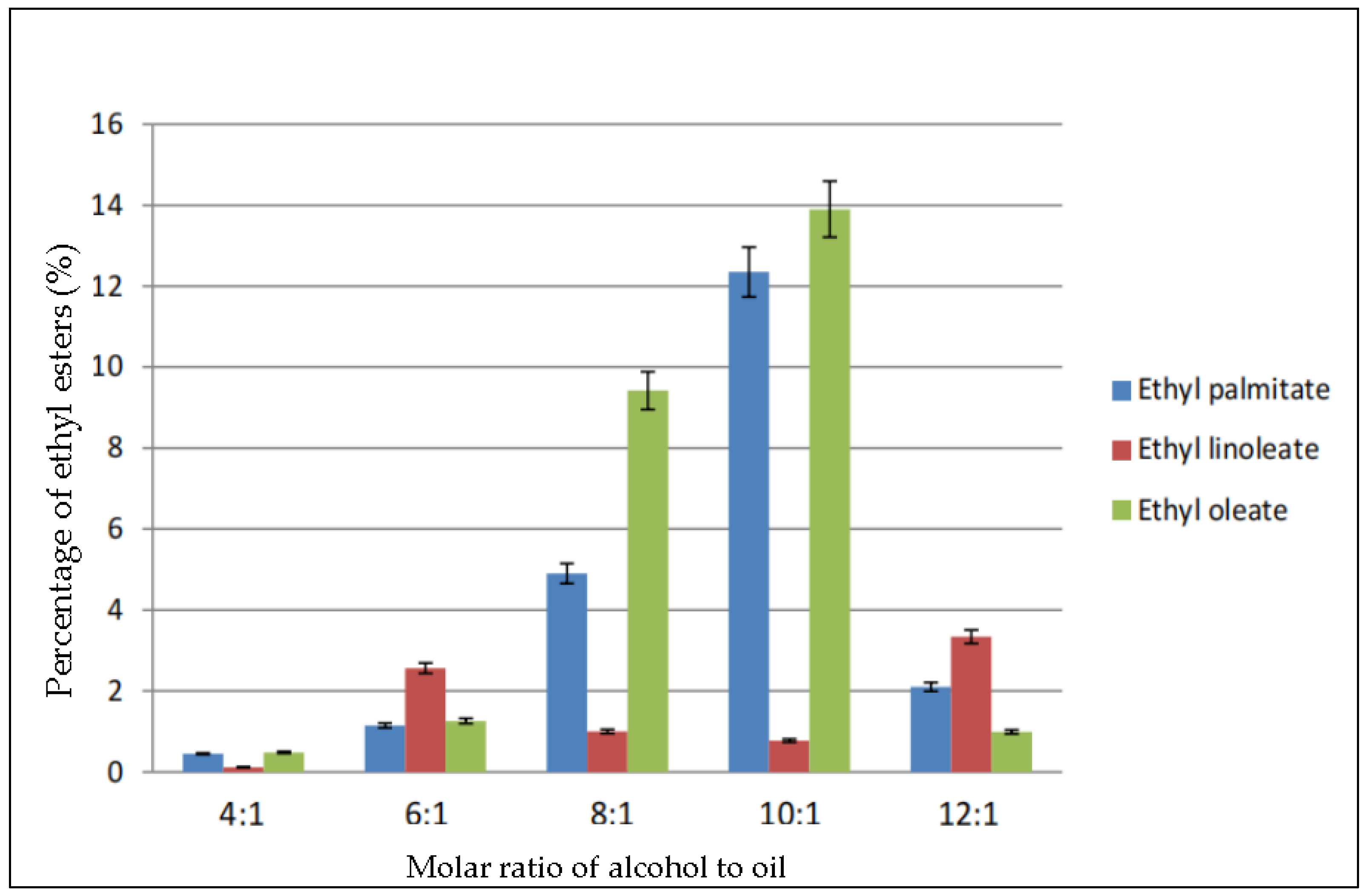
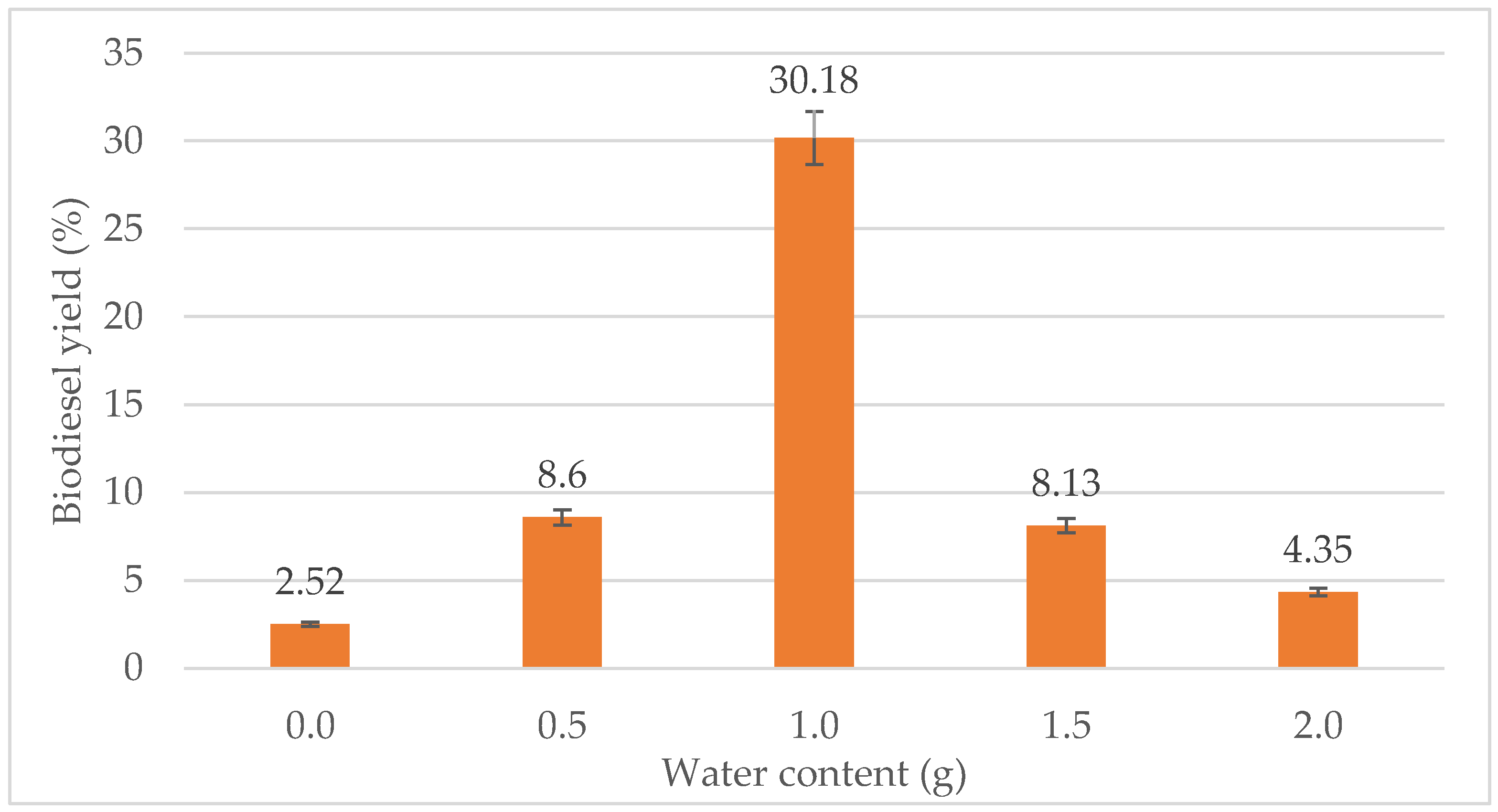

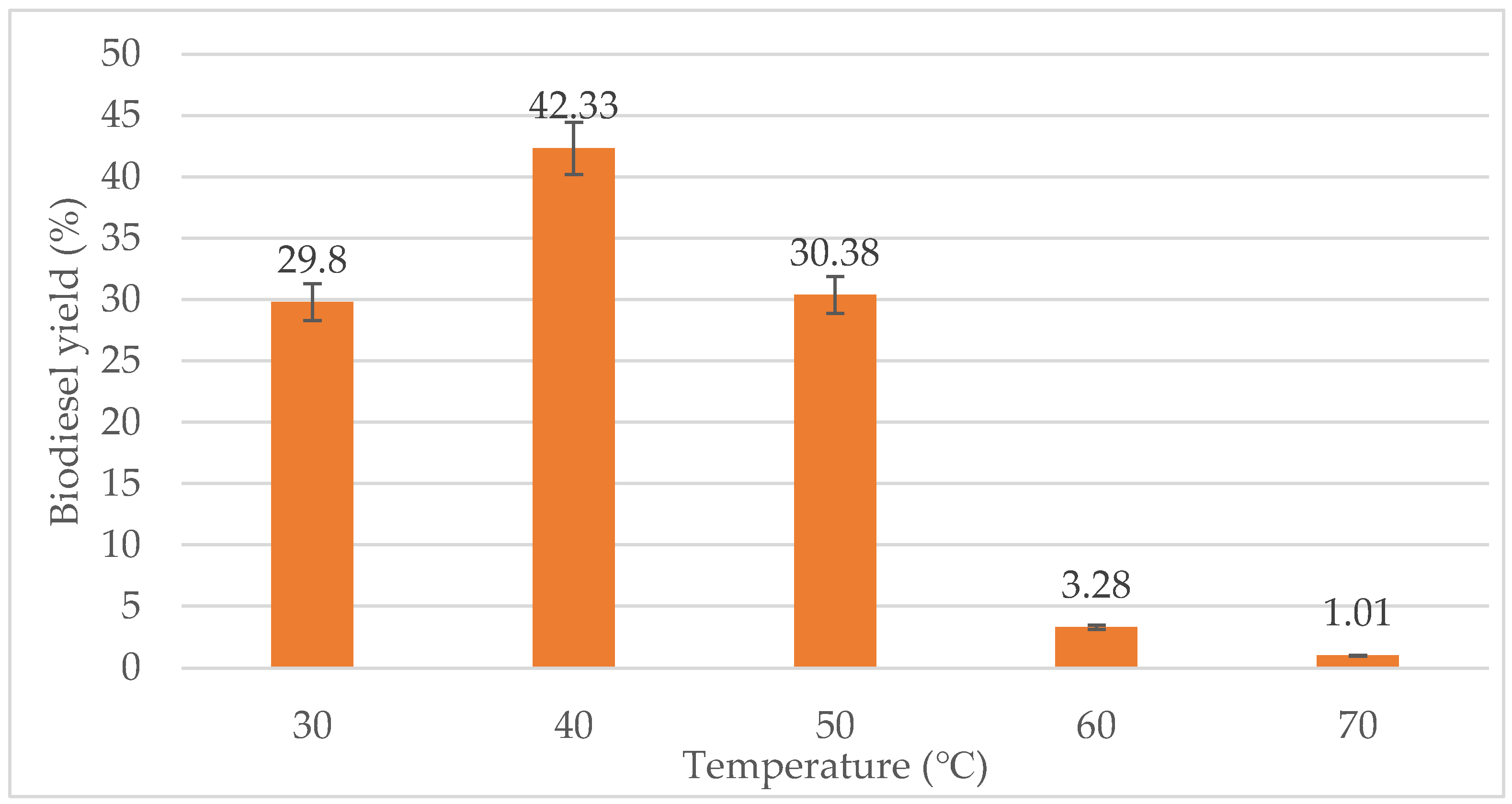
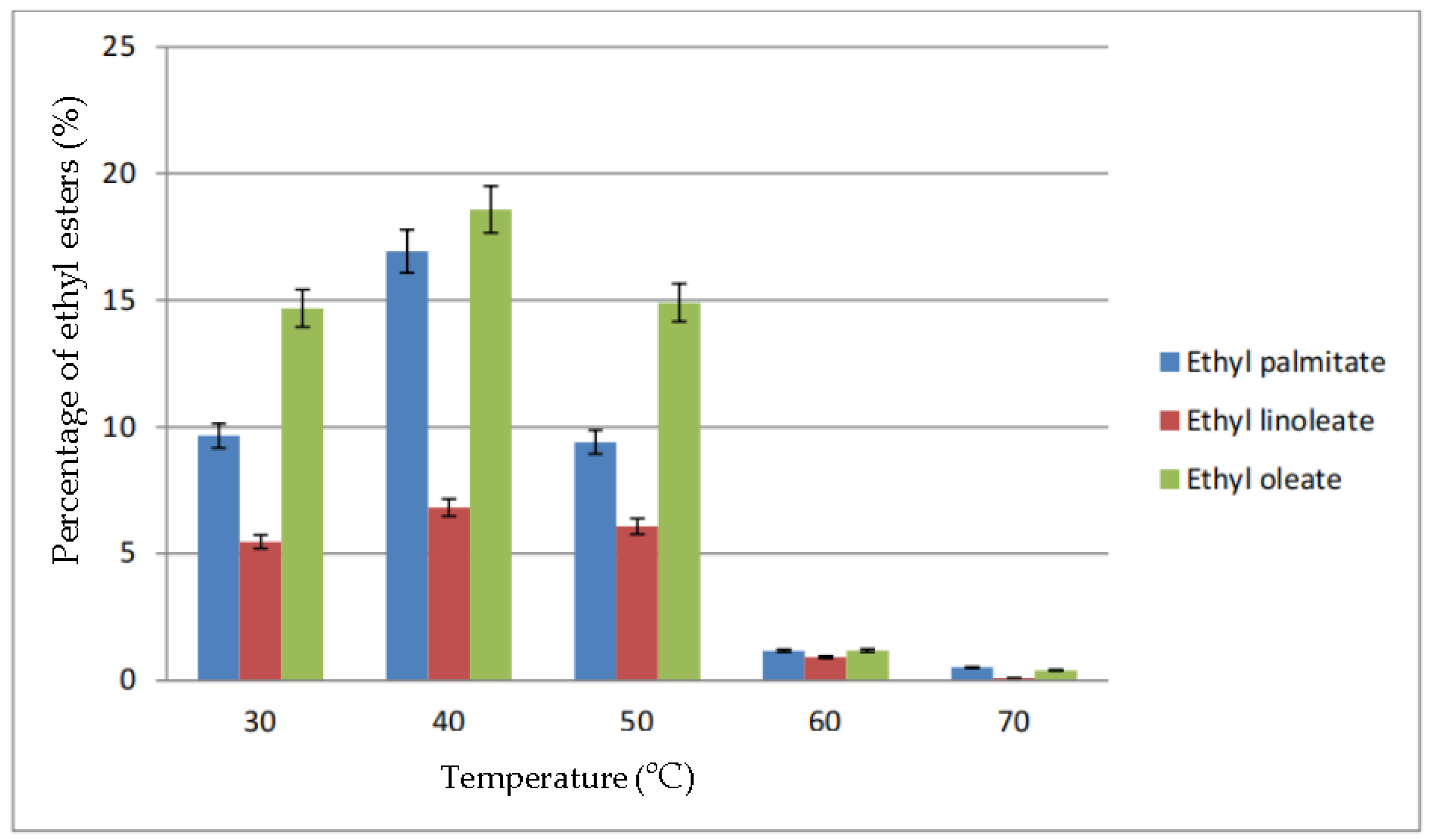
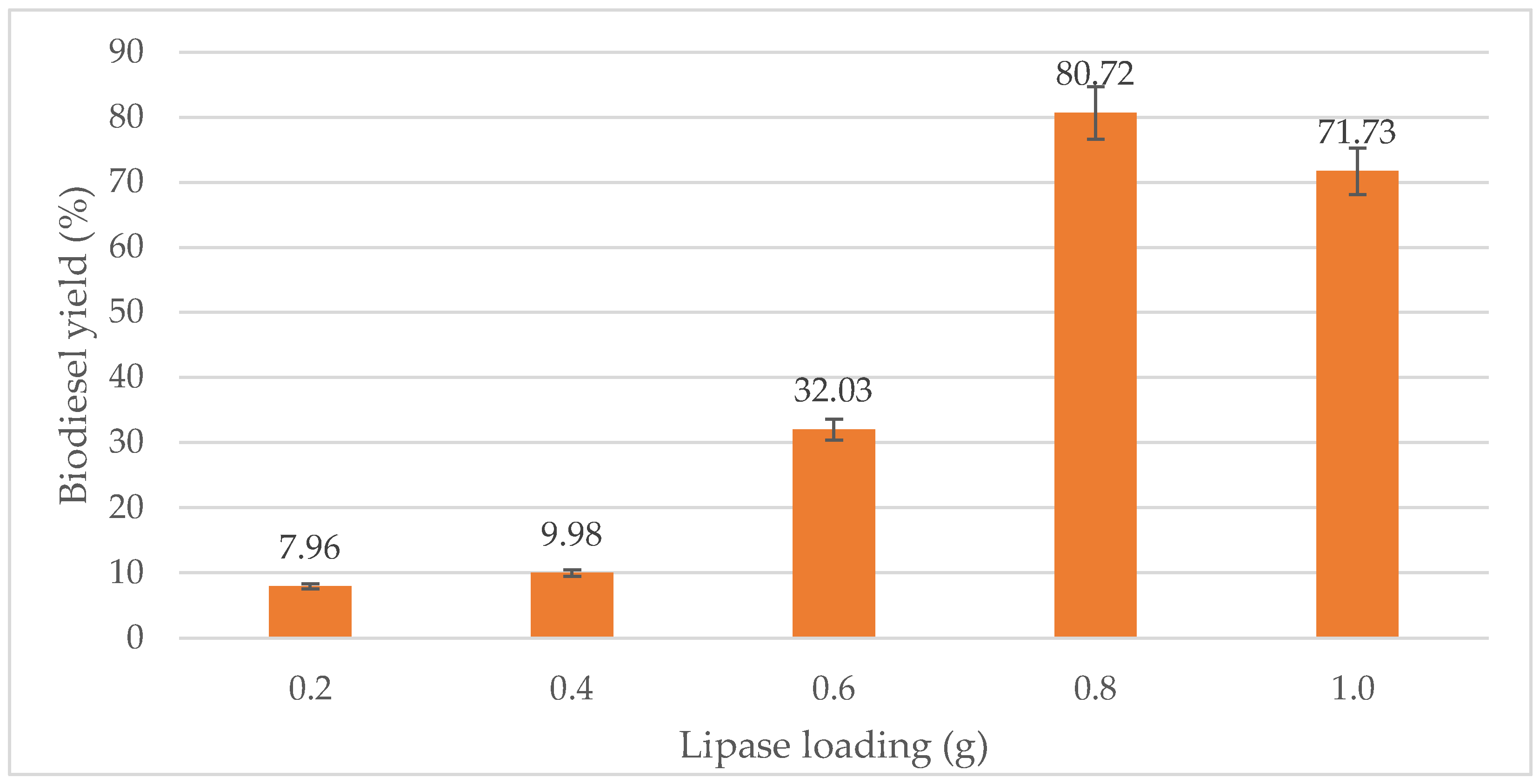
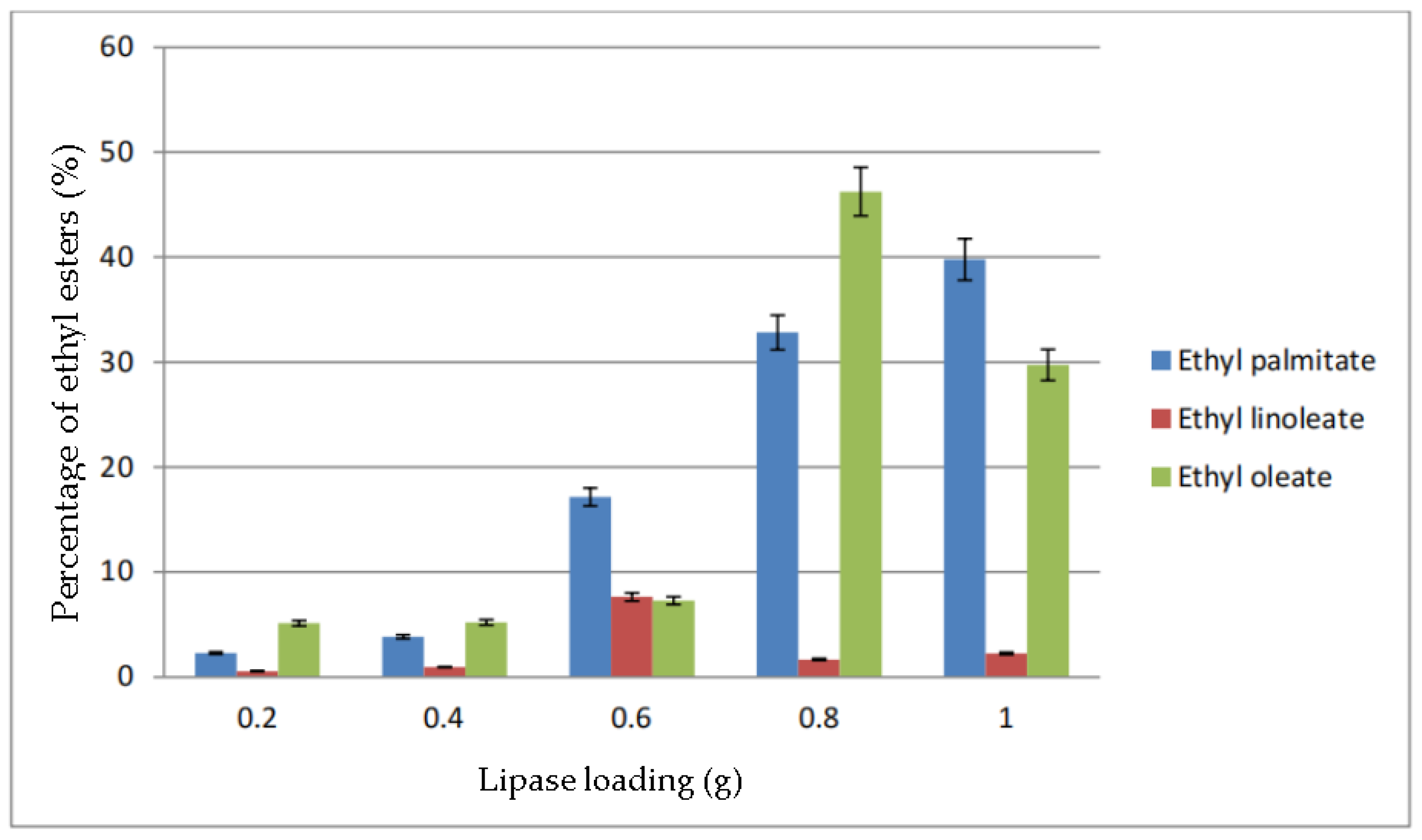
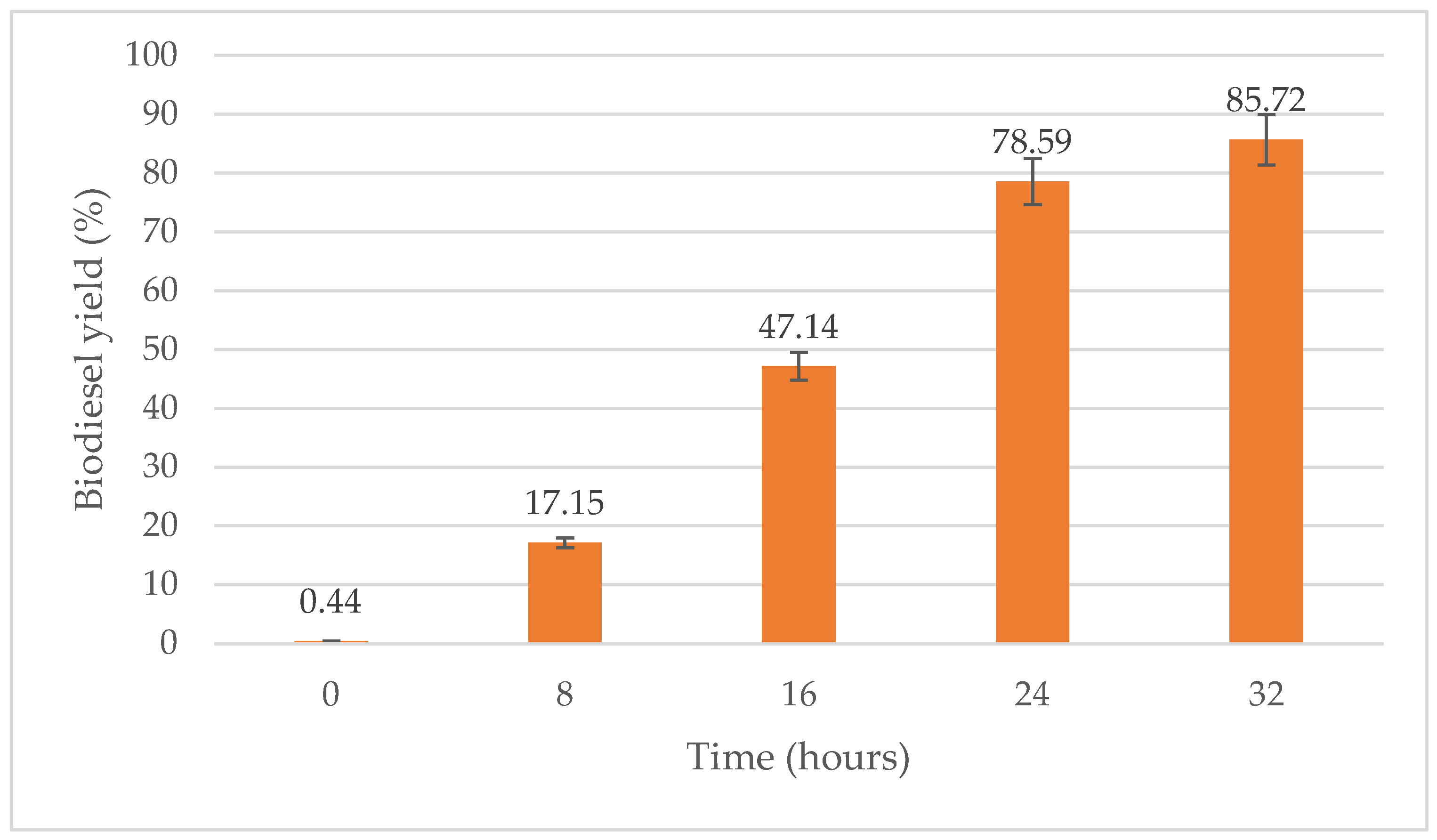

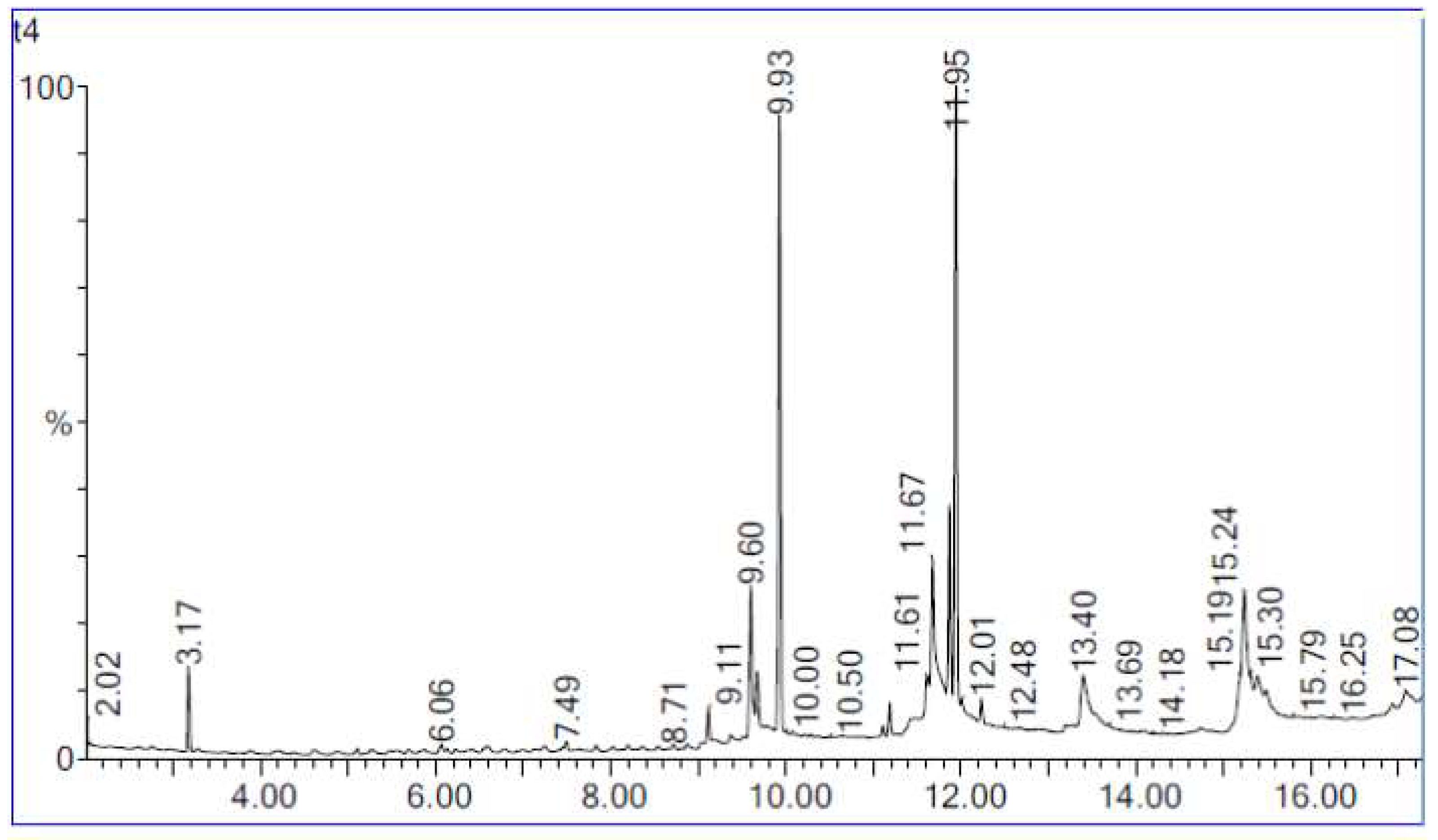
| Composition | Waste Palm Cooking Oil (%) | |||
|---|---|---|---|---|
| Lauric acid | 46.2 | 0.86 | - | 2.8 |
| Stearic acid | 2.6 | 2.67 | 1.92 | 2.1 |
| Linoleic acid | 1.7 | 23.82 | 19.7 | |
| Linolenic acid | - | - | 10.2 | 2.9 |
| Oleic acid | 6.1 | - | 61.20 | 55.3 |
| Myristic acid | 17.1 | - | 0.05 | 0.8 |
| Caprylic acid | 9.3 | 0.56 | - | - |
| Capric acid | 9.1 | 2.43 | - | - |
| Caproic acid | 1.8 | - | - | - |
| Palmitic acid | 7.8 | - | 0.28 | 2.0 |
| Palmitoeic acid | - | - | 0.2 | - |
| Pantane | - | - | - | 13.9 |
| Erucid acid | - | 6.83 | - | - |
| Enanthic acid | - | 0.82 | - | |
| Margaric acid | - | - | 0.03 | - |
| Gadoleic acid | - | - | 1.52 | - |
| Arachidic acid | - | - | - | 0.6 |
| References | [23] | [40] | [43] | [42] |
| Feedstock | Optimum Reaction Conditions | Optimum Biodiesel Yield (FAEE) (%) | References |
|---|---|---|---|
| Waste Palm Cooking Oil | 10:1 ethanol to oil ratio, 1.0 g of water content, 0.8 g lipase loading, 32 h and 40 °C | 85.72 | This study |
| Jatropha curcas L. oil | 10:1 ethanol to oil ratio, 1 g water, 5.25 g immobilized lipase, 6 g RCF, 24 h and 35 °C | 100 | [17] |
| Prosopis julifera seed oil | 10:1 ethanol-to-oil ratio, 5% magnesium oxide concentration, 1000 rpm agitation rate, 80 min and 45 °C | 94.83 | [48] |
| Waste cooking oil | 12.9:1 ethanol to oil ratio, 1.62 wt% catalyst concentration and 200 rpm of stirring speed | 89.75 | [62] |
| Residual oil palm from babassu (Orbignya sp.) | 18:1 ethanol to oil ratio, 0.14 g of Novozym® 435, 4 h and 48 °C | 96.8 | [63] |
| Waste cooking oil | 12:1 ethanol to oil ratio, 4 wt% catalyst dosage, 3 h of UV irradiation, 3 h of reaction time and 35 °C | 96.14 | [64] |
Publisher’s Note: MDPI stays neutral with regard to jurisdictional claims in published maps and institutional affiliations. |
© 2022 by the authors. Licensee MDPI, Basel, Switzerland. This article is an open access article distributed under the terms and conditions of the Creative Commons Attribution (CC BY) license (https://creativecommons.org/licenses/by/4.0/).
Share and Cite
Abdulla, R.; Derman, E.; K.Mathialagan, T.; Yaser, A.Z.; Abu Samah, M.A.; Gansau, J.A.; Syed Najmuddin, S.U.F. Biodiesel Production from Waste Palm Cooking Oil Using Immobilized Candida rugosa Lipase. Sustainability 2022, 14, 13632. https://doi.org/10.3390/su142013632
Abdulla R, Derman E, K.Mathialagan T, Yaser AZ, Abu Samah MA, Gansau JA, Syed Najmuddin SUF. Biodiesel Production from Waste Palm Cooking Oil Using Immobilized Candida rugosa Lipase. Sustainability. 2022; 14(20):13632. https://doi.org/10.3390/su142013632
Chicago/Turabian StyleAbdulla, Rahmath, Eryati Derman, Thivyasri K.Mathialagan, Abu Zahrim Yaser, Mohd Armi Abu Samah, Jualang Azlan Gansau, and Syed Umar Faruq Syed Najmuddin. 2022. "Biodiesel Production from Waste Palm Cooking Oil Using Immobilized Candida rugosa Lipase" Sustainability 14, no. 20: 13632. https://doi.org/10.3390/su142013632
APA StyleAbdulla, R., Derman, E., K.Mathialagan, T., Yaser, A. Z., Abu Samah, M. A., Gansau, J. A., & Syed Najmuddin, S. U. F. (2022). Biodiesel Production from Waste Palm Cooking Oil Using Immobilized Candida rugosa Lipase. Sustainability, 14(20), 13632. https://doi.org/10.3390/su142013632






